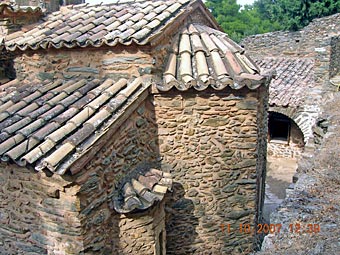Type: Cross-in-Square
Date: 15th - 17th century
Description:
Asteriou Monastery is in a protected area, in the northeast of Kaisariani Monastery. The katholikon is a complex, cross-in-square church. They used to believe it was dated to the 11th century. It is rubble masonry and the dome is Athenian.
Legend has it that it was named after Hosios Loukas Steiriotis, founder of the Monastery in Boeotia, who remained for a certain period in Athens, probably in this specific Monastery. If this is true, the Monastery must have existed before 1000, that is during the years the saint lived.
According to certain scholars, the Monastery was built where the ancient school of the philosopher Diodoros used to be.
However, according to Pr. Bouras, it is dated to the first post Byzantine period (1453-1700). Thus, the previous references are more related to the position than to the monument itself. Bouras claims that the middle Byzantine characteristics such as the architectural type, the Athenian dome, the wall paintings etc, are nothing else than the expression of the owners’ desire to imitate the middle Byzantine churches of Attica in buildings of similar dimensions.
The monastic complex is almost fully preserved. It includes a four-sided yard, two building wings and the katholikon in the midst of the yard. The northern wing of the cells consists of the barrel-vaulted gate, the old Refectory and finally, in the northwestern corner, the new Refectory with the wall painting of the Virgin Mary (17th century). The western wing, apart from the new Refectory, comprises a series of vaulted areas that must have served various needs of the Monastery, and possibly the monks’ cells in today’s ruined floor. Moreover, in the Monastery entrance we can find a fountain dated to the years of the Turkish domination. The wall paintings are dated to the 17th century.
Koder J.-Hild F., Hellas und Thessalia, Tabula IMperii Byzantini I, Wien 1976, p. 268.











